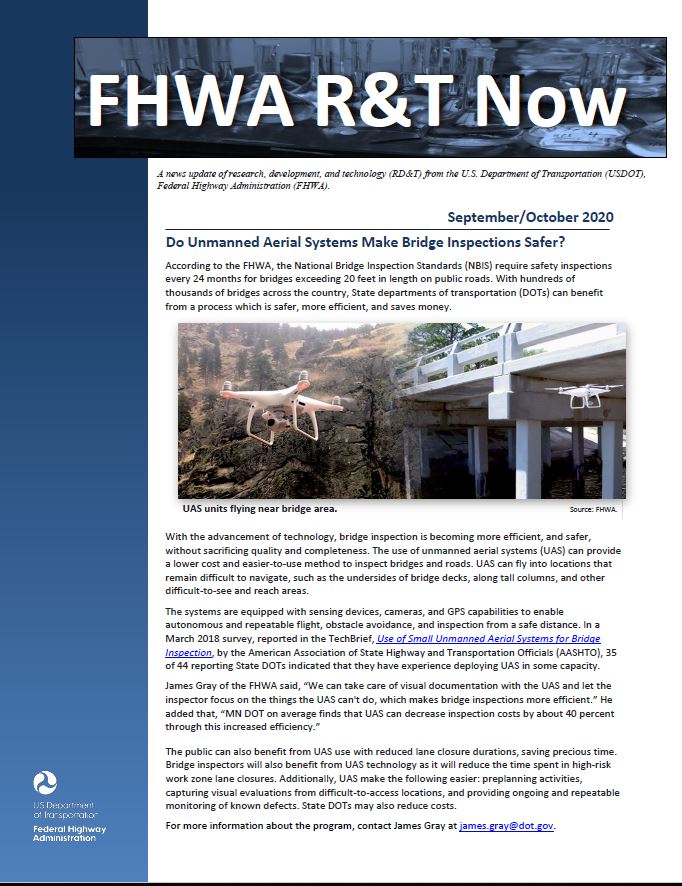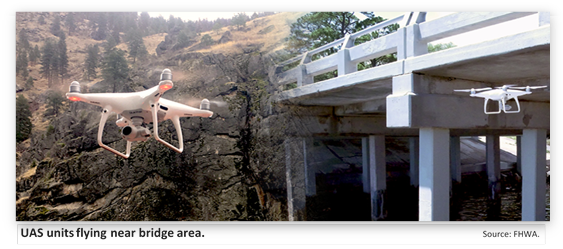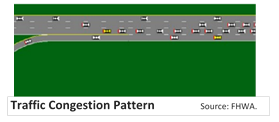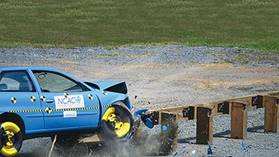U.S. Department of Transportation
Federal Highway Administration
1200 New Jersey Avenue, SE
Washington, DC 20590
202-366-4000
Federal Highway Administration Research and Technology
Coordinating, Developing, and Delivering Highway Transportation Innovations
|
R&T NOW This newsletter is an archived publication and may contain dated technical, contact, and link information. |
|
| Publication Number: Date: September/October 2020 |
Publication Date: September/October 2020
|

PDF files can be viewed with the Acrobat® Reader®
In this issue…
According to the FHWA, the National Bridge Inspection Standards (NBIS) require safety inspections every 24 months for bridges exceeding 20 feet in length on public roads. With hundreds of thousands of bridges across the country, State departments of transportation (DOTs) can benefit from a process which is safer, more efficient, and saves money.

UAS units flying near bridge area.
With the advancement of technology, bridge inspection is becoming more efficient, and safer, without sacrificing quality and completeness. The use of unmanned aerial systems (UAS) can provide a lower cost and easier-to-use method to inspect bridges and roads. UAS can fly into locations that remain difficult to navigate, such as the undersides of bridge decks, along tall columns, and other difficult-to-see and reach areas.
The systems are equipped with sensing devices, cameras, and GPS capabilities to enable autonomous and repeatable flight, obstacle avoidance, and inspection from a safe distance. In a March 2018 survey, reported in the TechBrief, Use of Small Unmanned Aerial Systems for Bridge Inspection, by the American Association of State Highway and Transportation Officials (AASHTO), 35 of 44 reporting State DOTs indicated that they have experience deploying UAS in some capacity.
James Gray of the FHWA said, "We can take care of visual documentation with the UAS and let the inspector focus on the things the UAS can't do, which makes bridge inspections more efficient." He added that, "MN DOT on average finds that UAS can decrease inspection costs by about 40 percent through this increased efficiency."
The public can also benefit from UAS use with reduced lane closure durations, saving precious time. Bridge inspectors will also benefit from UAS technology as it will reduce the time spent in high-risk work zone lane closures. Additionally, UAS make the following easier: preplanning activities, capturing visual evaluations from difficult-to-access locations, and providing ongoing and repeatable monitoring of known defects. State DOTs may also reduce costs.
For more information about the program, contact James Gray at james.gray@dot.gov.Merging, diverging, and weaving areas on freeways are major bottlenecks that cause ongoing congestion issues. An Office of Operations Research and Development (R&D) study evaluated five alternative infrastructure designs for application at bottleneck areas. The final report, Alternative Designs to Alleviate Freeway Bottlenecks at Merging, Diverging, and Weaving Areas, was published in May 2020. The report may be useful for State and local DOTs interested in exploring innovative methods to manage their facilities more effectively.

The primary research tool used for the study was sensitivity analyses via microscopic traffic simulation, also known as microsimulation. The alternative designs developed and evaluated through this research effort are split merge points, managed lanes on the right-hand side, mainline metering, coordinated ramp metering, and speed optimization via traffic calming devices.
Coordinated ramp metering did not show significant additional benefits beyond conventional asservissement lin'eaire d'entr'ee autorouti'ere, also known as ALINEA, metering. ALINEA is a relatively new local traffic-response strategy to address ramp metering. The strategy is based on a feedback structure and is derived using classical automatic control methods. Speed optimization showed excellent benefits but only during narrow ranges of traffic congestion. Mainline metering also showed reasonably good benefits but could be challenging to implement. It is conceivable that speed optimization and mainline metering could produce more favorable benefit-cost ratios if implemented via connected and automated vehicle (CAV) technologies.
Results indicate that the split merge design, and positioning of managed lanes on the right side of the freeway, are two unrelated designs that showed excellent promise (in terms of benefit-cost ratio). The split merge and right-side managed lane designs produced excellent benefits without the need for CAV technologies.
For more information, contact Rachel James at rachel.james@dot.gov.
The FTA's Office of Research, Demonstration, and Innovation (TRI) hired former FHWA employee Mohammed Yousuf. Yousuf joins the FTA with almost 10 years of experience at the FHWA's Turner-Fairbank Highway Research Center. Yousuf was previously Program Manager for one of the USDOT's high-profile strategic programs, the $60M Automated Driving System (ADS) Demonstration Grants. While at the FHWA, he also created, launched, and implemented the Accessible Transportation Technology Research Initiative (ATTRI).
Yousuf joins the FTA's management team as the new Director for the Office of Infrastructure and Asset Innovation (TRI-20). His first day in his new position was June 22, 2020, and his new responsibilities include managing the FTA’s research portfolio on safety, infrastructure, and asset management, as well as oversight of the bus testing program where he led a seasoned team of experienced program managers and engineers.
Yousuf also spent time during his career at Chrysler Corporation and General Motors. He holds a BS in Electronics and Communication Engineering, and an MS in Computer Engineering.
How does an agency develop and share its Federal Outdoor Impact Laboratory (FOIL) crash tests with an online audience in a virtual environment? The solution may not be as easy as taking a video on a cell phone and streaming it live. Sure, a cell phone can take a video of a vehicle crashing into a barrier, but a video does not show the purpose of the test nor enough detail to help with a solution.
A crash test is destructive testing performed on vehicles to ensure safe design standards in crashworthiness. A challenge to presenting crash tests across the Internet is that the equipment used for crash tests is not actually intended to be used in this way.
Cameras used in crash tests are not like personal video cameras. Crash test cameras are designed to withstand G-Forces experienced during crash events. The high-resolution cameras can capture more frames per second than commercial cameras and can record up to 1,000 frames per second—while commercial cameras capture 60 frames per second. All this detail translates into extremely large files.

During a crash test, several video views (7 to 9) are recorded at very high frame rates—500 to 1,000 frames per second. The video files are recorded internally to each camera, but then the extremely large files must be downloaded through a high-speed, wired connection, which can take up to 30 minutes.
According to FOIL Manager Eduardo Arispe of the FHWA, "Although we are not currently able to use our cameras to webcast the tests in a live stream, laptops with wireless connections and internal cameras do allow us to show several different live views of the test. The videos from the "official" seven to nine cameras are later emailed to the audience after those files have been downloaded and converted."
Arispe continued, "And most important, the videos would not show the whole picture." A crash test is not composed of just videos. Crash tests also rely on sensor equipment and heavy data analysis to help researchers find the reasons for the problem. In combination with the video, pre- and post- vehicle measurements, and sensor data will be compiled and studied to build a three-dimensional model that will be put through a variety of scenarios.
And finally, the scenarios will be analyzed to find a solution. Even though FHWA is testing various equipment to bring a live video stream to the Internet, the video is only part of the crash test. In the words of famous radio personality Paul Harvey, and then there is "the rest of the story."
For more information, contact Eduardo Arispe at eduardo.arispe@dot.gov.
FHWA has received many requests to install colored aesthetic treatments within crosswalks. However, when changing recognizable transportation devices such as crosswalks, many questions would need to be answered to ensure the safety of the traveling public. Would different colors be distracting for drivers? Would the colors be recognized as a crosswalk by pedestrians and drivers? Would the colors be as effective as white pedestrian crosswalk markings when seen from a distance? These types of questions and many others would need answers before implementing changes that might affect safety.
The Office of Operations, Manual on Uniform Traffic Control Devices (MUTCD) Team and the Office of Safety R&D are collaborating on the research study Evaluation of Aesthetically Treated Crosswalks. The study focuses on a rainbow color pattern since there is significant interest in its use with crosswalks.
Through closed-course studies, this project will evaluate the impact that aesthetic treatments have on motorists' and pedestrians' recognition and behavior at crosswalks, including pedestrians with low vision. The study will also attempt to determine what conditions or aspects of the aesthetically treated crosswalks impact road user recognition and behavior.
Road users include drivers and pedestrians (with normal and low vision). The project began on June 1, 2020 and is scheduled for completion by May 31, 2022.
The results of the study will identify not only the impact of aesthetically treated crosswalks on road user's recognition and behavior, but also what conditions or aspects of the aesthetically treated crosswalks have the most impact. This will allow the FHWA to identify the crosswalk designs that do not impact recognition and behavior, if any exist. These results will also inform FHWA's future decisions on aesthetically treated crosswalks.
For more information, contact Ann Do at ann.do@dot.gov.
The NDE Program hosts monthly webinars that focus on bridge, tunnel, and pavement applications. The goal of the webinars is to provide education on how different States use NDE technologies, their current practices, challenges, added value, policies, future visions, and recommendations to other States.
The webinars are held the last Monday of every month at 1 p.m. (EST) and provide a platform for the State DOTs to exchange knowledge and innovation in highway infrastructure, as well as inform researchers, technology providers, and industry representatives about different States&aoos; current practices and policies. Additionally, the webinars share States' challenges and future directions regarding use of NDE for condition assessment of highway assets.
The following topics will be covered in upcoming meetings:
September — Minnesota DOT will be talking about an advanced NDE technology that can provide continuous and complete roadway information by integrating state-of-the-art hardware for pavement data collection and advanced software for processing, synchronization, and visualization of the data. The advanced technologies can provide information on:
October — Indiana DOT will discuss how they use NDE for bridge deck maintenance and to support their bridge management program.
November — Florida DOT will present how they use NDE to detect the location and severity of delamination in pavements.
For more information about attending these webinars, contact Hoda Azari at hoda.azari@dot.gov.
In this issue: Get Ready for Every Day Counts Round Six. Agencies CHANGE Hydraulic Modeling Approach. Playing the A-GaME to Improve Reliability and Reduce Risk. Innovation Synergy.
Iowa Creates Virtual Public Involvement Tool.
States Innovate. FHWA Innovation Conversation.
The September/October 2020 issue is available at: https://www.fhwa.dot.gov/innovation/innovator/issue80/.
The September 10, 2020, issue of EDC News was released. The articles are as follows: Innovation of the Month: Collaborative Hydraulics: Advancing to the Next Generation of Engineering (CHANGE). GDOT Shares Lessons Learned from Virtual Public Information Open House. Getting "TUF" on Transportation Funding Gaps.
The September 10, 2020, issue is available at: https://www.fhwa.dot.gov/innovation/everydaycounts/edcnews/20200910.cfm.
Under the leadership of the U.S. Transportation Secretary, Elaine l. Chao, HEP serves as FHWA’s advocate and national leader for environmental protection and enhancement, comprehensive intermodal, and multimodal transportation planning, and for fair and prudent acquisition and management of real property.
The latest HEP updates are available at: https://www.fhwa.dot.gov/hep/whats_new/
The Summer 2020 issue of Public Roads magazine is now available on the FHWA website. In this issue: Can Augmented Reality Address Highway Construction Challenges? CARMAsm: Enabling Collaboration and Ensuring Safety in Freight Operations. Going-to-the-Sun Road: Construction and Restoration. Everybody Wins. Facing Volcanic Challenges.
The summer issue is available at: https://www.fhwa.dot.gov/publications/publicroads/20summer/index.cfm.
For more information or to submit an article, contact Maria Romstedt at maria.romstedt@dot.gov.
www.fhwa.dot.gov/resourcecenter/
http://www.nhi.fhwa.dot.gov/home.aspx
FHWA R&T Now is a newsletter containing information and updates about research, technology, and development from the U.S. Department of Transportation, Federal Highway Administration. The newsletter is an electronic newsletter and is updated approximately every other month.
Send your comments, questions, and feedback to FHWA_Now@dot.gov.
Online access:
https://www.fhwa.dot.gov/publications/rtnow/.
Mail:
Federal Highway Administration
FHWA Office of Research, Development, and Technology
Attention: Dawn Vanlandingham
6300 Georgetown Pike
McLean, VA 22101
Distribution–FHWA R&T Now is being distributed according to a standard distribution. Direct distribution is being made to the FHWA Divisions and Resource Center.
Key Words–Infrastructure, Operations, Safety, EAR, exploratory advanced research, research, V2X Hub, technology transfer, T2, nondestructive evaluation, NDE lab, crowdsourcing, CACC, cooperative adaptive cruise control, vehicle string, crash test, cell phone, managed lanes, alkali-silica reaction, ASR, simulator, asphalt, pavement test facility, indirect tensile-cracking test.
Notice–This document is disseminated under the sponsorship of the USDOT in the interest of information exchange. The U.S. Government assumes no liability for the use of the information contained in this document.
The U.S. Government does not endorse products or manufacturers. Trademarks or manufacturers' names appear in this report only because they are considered essential to the objective of the document.
Quality Assurance Statement–The Federal Highway Administration (FHWA) provides high-quality information to serve Government, industry, and the public in a manner that promotes public understanding. Standards and policies are used to ensure and maximize the quality, objectivity, utility, and integrity of its information. FHWA periodically reviews quality issues and adjusts its programs and processes to ensure continuous quality improvement.